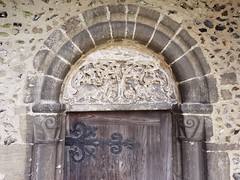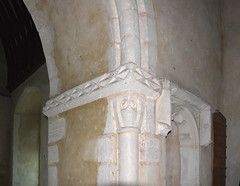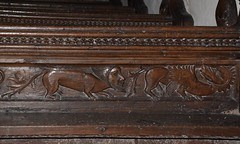| |
|
We're out in the Breckland
here, East Anglia's badlands, the wild heathland
heavily forested and cut through by busy roads.
Wordwell consists of the church, a few cottages
and the Hall behind, and that's all. Despite its
proximity to the horrible Bury to Brandon road
this is a charming building, no longer used for
worship and in the care of the Churches
Conservation Trust. It seems inevitable that some
of the churches in this area should become
disused. I counted sixteen medieval churches
within a five mile radius, and here, on the edge
of the Elveden forest, one of the most densely
populated areas of England in Saxon times, the
population has fallen dramatically in the last
couple of centuries. The
church is small, with plenty of evidence of its
Norman origins, though some good things happened
afterwards, especially in the late 15th Century,
as we will see inside. The church had fallen into
decay by the mid-19th Century and plans for a
restoration were drawn up in 1857 by Samuel
Teulon. Teulon was called in to preserve as much
as was possible, while restoring a sense of its
medieval past. However, it is not clear how much
work was carried out to Teulon's design, for as
James Bettley points out in his revision of the Buildings
of England volume for West Suffolk, the
gable bellcote is dated 1866 and does not appear
on Teulon's plans. It is likely that the church
as we see it today is essentially the work of the
wealthy Reverend Edward Benyon of Culford, who
owned all the land in the parish and was
rebuilding the church at Culford at about the
same time.
The rustic little south
porch is Teulon's, and conceals an early 12th
Century south doorway with a carved tympanum.
This is a flourish of foliage, with two
creatures, possibly dogs, at the base with raised
heads howling. The branches seem to grow from
their tails. The carving is relatively
sophisticated, but below it to the right, at the
capital of the door post, is something curious, a
primitive carving of a man. A mason's mark,
perhaps?
  
  
You step into an interior
that is full of charm, with no coloured glass and
an intimate expanse of old woodwork and stone. An
11th Century tympanum comes into view above the
north door, turned inwards although it must once
have faced outwards. Here, two primitive figures
stand. One holds what appears to be a ring, and
the other's arms are open wide in surprise, or in
a gesture of revelation. It might well depict the
story of Edward the Confessor giving his ring to
a beggar, who reveals himself as St John the
Baptist. If this is the case, than the carving
would be pretty much contemporary with the
legend. James Bettley wondered if alternatively
the figure on the right might be elevating a host
and the figure on the left venerating it.
For such a small church, a
remarkable amount of its past is preserved. The
Norman tub font is raised on square legs with
what appear to be primitively carved heads on
them. The neo-Noman chancel is charming, and is
likely to be Teulon's. The stone pulpit is
unfortunate and dates from Benyon's later
restoration. It replaced a Stuart pulpit that had
arrived from elsewhere. But most memorable in the
nave is a pretty much complete range of 15th
Century benches with decoratively carved backs
and figures on bench ends. These include a beast
with the head of a bearded man, a collared lion,
and what appears to be an ape in a monk's habit,
a common late medieval satire on itinerant
friars, but what is he holding? Most remarkable
is the bench back nearest the door. Here, dragons
and creatures with human heads chase and roar at
each other, as if illustrating some
long-forgotten children's tale.
  
The 12th Century Norman
chancel arch with its intricately carved capitals
is flanked by two impressive image niches of the
15th Century which presumably once had altars
beneath them. It is curious to note that both
south doorway and chancel arch postdate by
perhaps half a century the tympanum now set above
the north doorway. It may well be that the
tympanum came from elsewhere, but it also
suggests the intriguing possibility that there
was a stone church on this site which predated
the 12th Century one.
Wordwell and nearby West
Stow became a joint benefice not long after the
Reformation, and at the time of the 1851 Census
of Religious Worship they were in the care of the
Reverend W Pridden, Rector of West Stow. Pridden
received £380 a year for his joint incumbency,
roughly £70,000 in today's money. However, he
pointed out in the census return that of the more
than five thousand acres in the two parishes, all
but three acres were owned by the Reverend Edward
Benyon of Culford. On the morning of the census
Pridden had a congregation at Wordwell of twenty
eight, along with the thirty four scholars of
West Stow school, some of whom would have been
Wordwell children. Given that the population of
Wordwell was just fifty six, at a time when rural
East Anglian populations were reaching a peak,
this would have been well above the average in
what was an enthusiastically non-conformist area,
although no doubt the Reverend Benyon had an
influence. There are certainly many fewer than
that living in the parish today.
|
|
|

